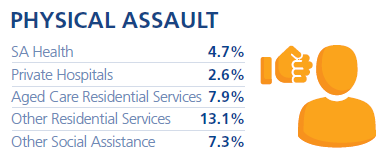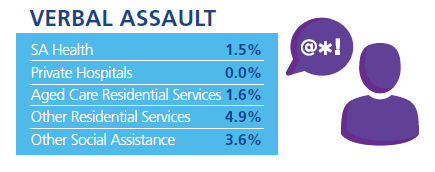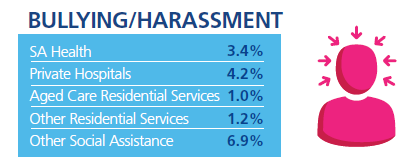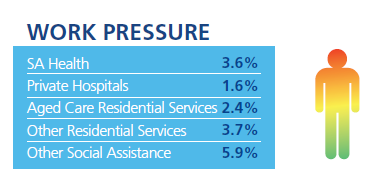Challenging behaviour, violence and aggression (CBVA) in the workplace extends throughout the health care and social assistance sector, from the ambulance service, hospitals and aged care facilities, to in-home care settings and beyond.
Challenging behaviour is defined as ‘any behaviour with the potential to physically or psychologically harm another person or self or property'. It can range from verbal abuse through to threats or acts of physical violence’ (SA Health, 2016).
Exposure and incidents
Health care and social assistance workers may be exposed to a range of challenging behaviours from the public, patients, residents, or family members.
Challenging behaviour can:
- potentially or actually stop, interrupt or limit the ability for health service or care to be provided in a way that is safe for both consumer and workers
- result in a person or people feeling unsafe or threatened or feeling that intervention, or retreat/withdrawal, is warranted to avoid or limit, physical or psychological harm to someone, or property.
CBVA also includes workplace bullying as well as incidents that are premeditated by persons with decision making capacity, and have an escalated outcome.
CBVA incidents may be service-related or external.
Service-related incidents may arise when providing a service to consumers. It can be intentional, deliberate or unintentional when associated with medical conditions such as delirium, dementia and psychosis.
External incidents arise when a person outside the work and care environment displays aggressive or challenging behaviour to a worker or at a workplace. It is commonly associated with crime e.g. robbery, assault including assault to ambulance officers, or threats to harm.
Risk factors
There are a range of risk factors that can impact health professionals’ mental health and wellbeing at work.
These include heavy workloads, long working hours, shift work, compassion fatigue, occupational violence, exposure to trauma, bullying and harassment, and abuse/mistreatment from patients and patients’ families.
Single or multiple exposures to workplace violence including challenging behaviour, work pressure, work-related harassment and/or workplace bullying can adversely affect workers’ psychological and physical health.
Each year the cost of psychological claims is more than double that of physical claims.




Source: Data is comprised from SA Health (including SA Ambulance Services), private hospitals, aged care residential services, other residential services and other social assistance sectors accepted claims in 2017.
CBVA should never be seen as 'part of the job' for any healthcare worker.
There are preventative actions and responses that can be taken to reduce the risk of CBVA in the workplace.
Preventative actions and response
CBVA should never be seen as 'part of the job' for any healthcare worker.
There are preventative actions and responses that can be taken to reduce the risk of CBVA in the workplace.
Does your organisation:
- have a policy and guidelines for the prevention and response to CBVA?
- use a CBVA hazard identification and risk assessment tool in consultation with workers, volunteers, supervisors and managers?
- need a challenging behaviour prevention and response committee, with terms of reference?
- have current evidence-based clinical guidelines and resources that describe best practice in the care and treatment of conditions that are associated with workplace challenging behaviour?
- conduct
- an analysis of workplace training and education needs to ensure all workers receive sufficient training, instruction and supervision?
- regular workplace training and education updates?
- an evaluation of the training and education program?
- have an organisational culture that encourages and ensures reporting and review of all incidents of challenging behaviour?
- monitor and evaluate all challenging behaviour incidents to demonstrate effective governance?
Further information
Challenging behaviour – from ambulance to bedside workshop resource list
Hands off our Ambos campaign - SA Health
Mentally Healthy Workplaces - ReturnToWorkSA


